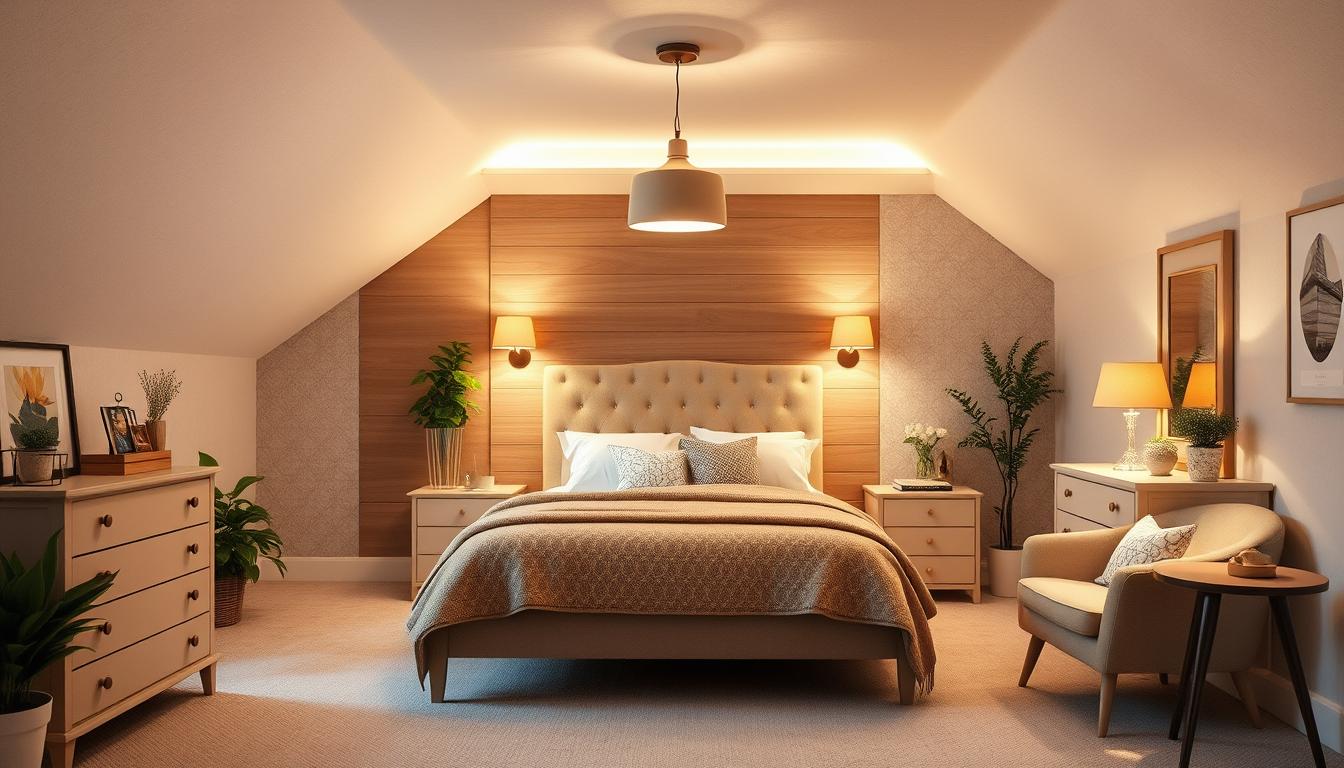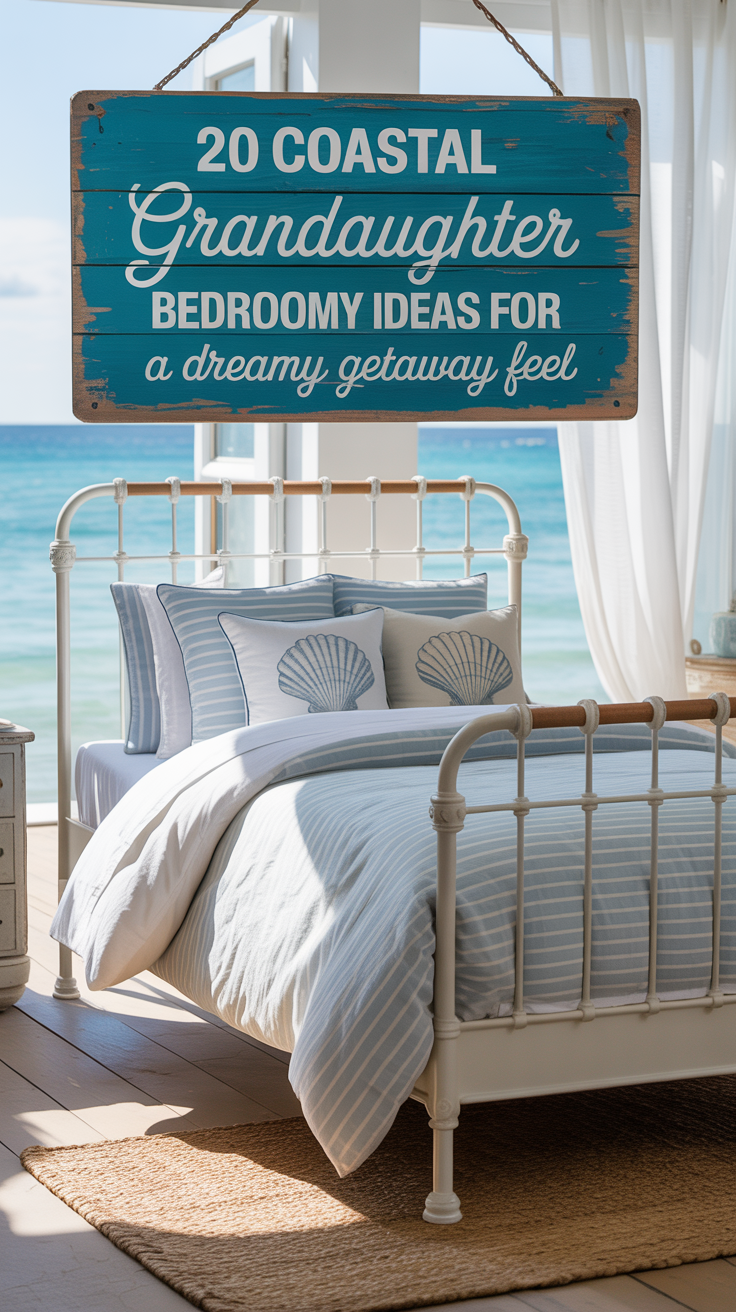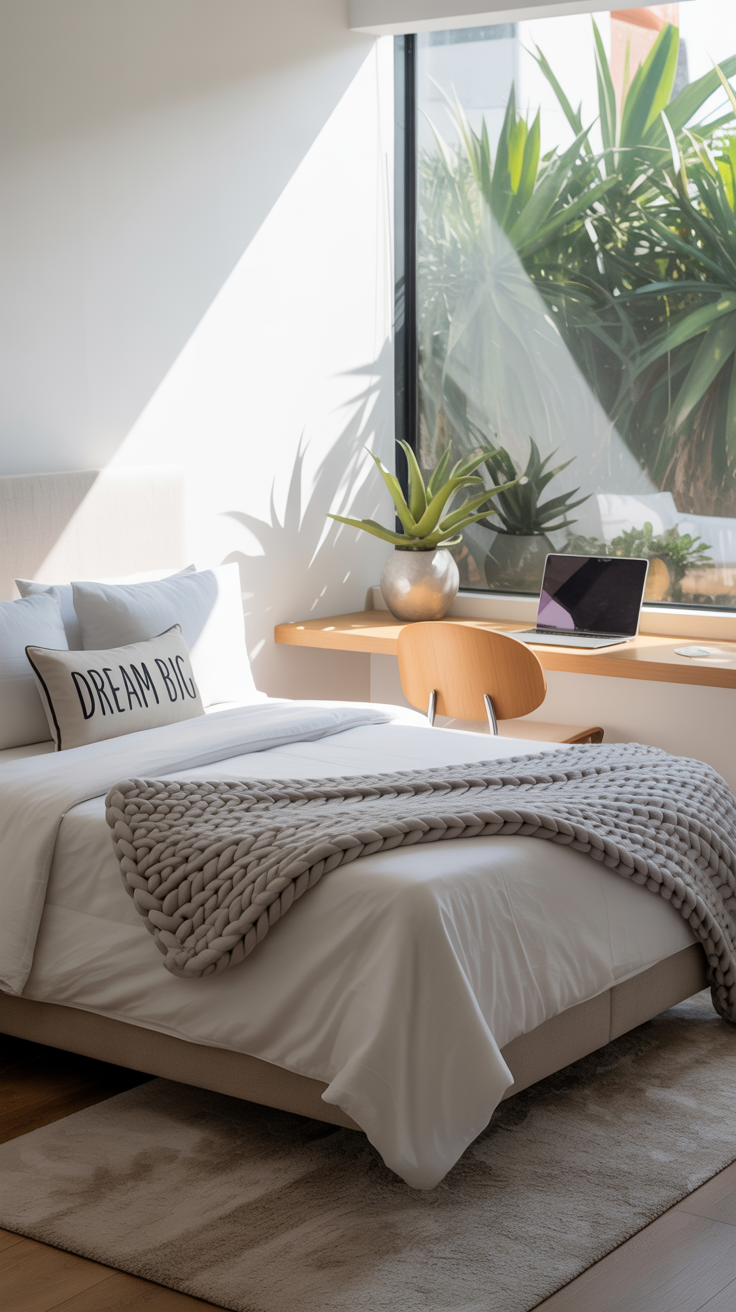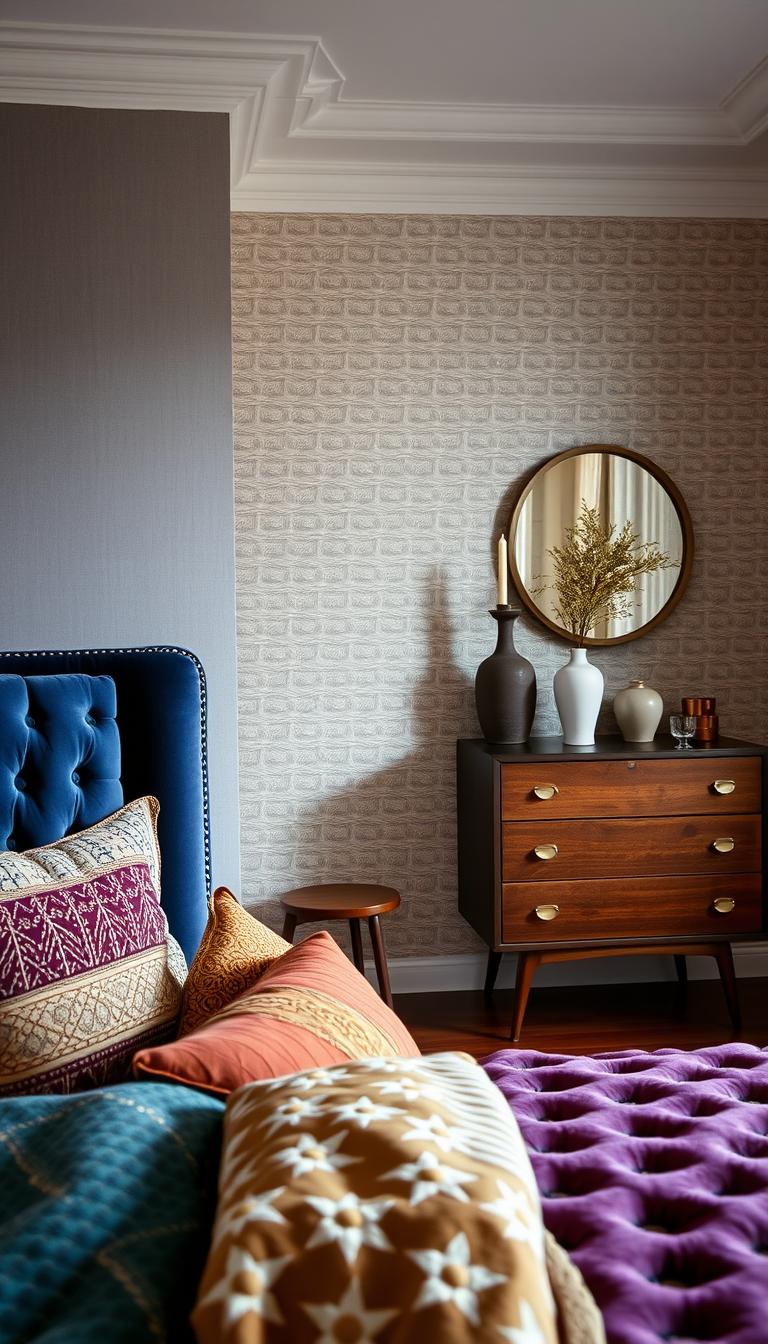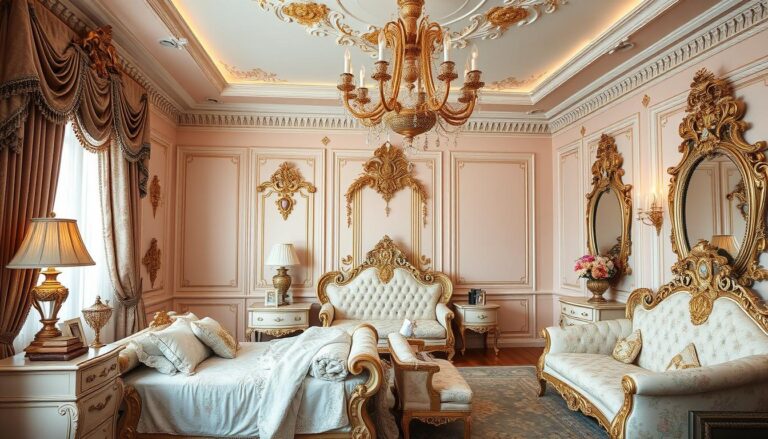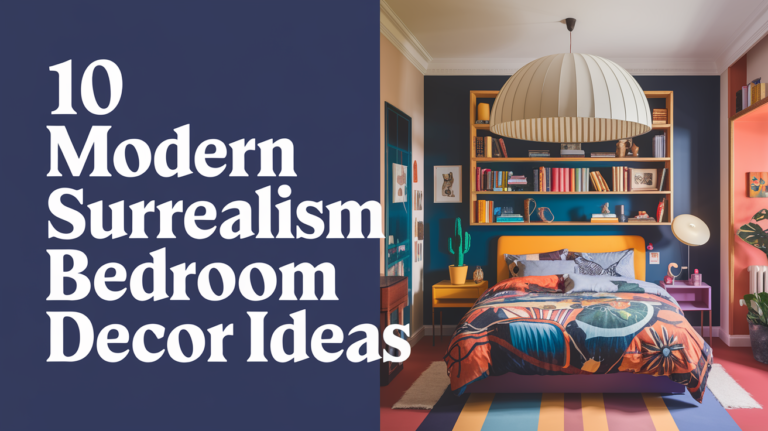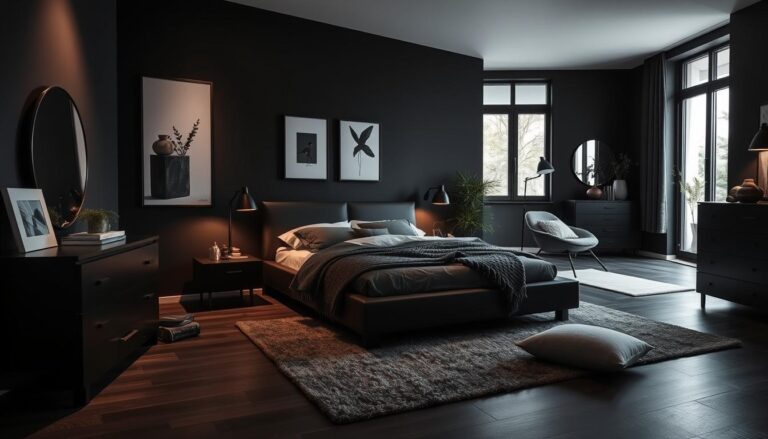10 Inspiring Low-Ceiling Bedroom Designs
Did you know over 8,000 homeowners search for low ceiling bedroom solutions every month? Most design advice ignores these spaces. You might feel like the ceiling is pressing down when you enter your room.
Compact spaces are not design disasters. They are cozy opportunities in disguise. They say “let’s get intimate” instead of “let’s feel cramped.”
We’re going to show you how to make your space feel charming. These ideas aren’t just for fancy homes. They’re real solutions for real spaces with real budgets.
Discover how creative lighting and smart furniture choices can make your low ceiling bedroom feel spacious. Ready to fall in love with your compact space?
Key Takeaways
- Light colors and reflective surfaces make rooms feel larger and more open
- Floor-to-ceiling elements draw the eye upward, creating height illusion
- Low-profile furniture maximizes space without overwhelming the room
- Strategic lighting placement can transform cramped spaces into cozy retreats
- Built-in storage solutions work perfectly in sloped ceiling areas
- Mirrors and vertical design elements add visual space and height
Maximizing Space in Low-Ceiling Bedrooms
To make a small, low-ceiling bedroom bigger, use every inch wisely. You need smart ideas and choices to make the most of your space.
Think of your room as a puzzle. Every piece must fit perfectly. You’re creating a space that looks bigger than it is.
Smart Furniture Choices
Choosing the right furniture is key for a small bedroom design with low ceiling. Low-profile beds are great because they make the room feel taller.
Platform beds are also good because they don’t need box springs. Beds with long, flat lines make the room look wider.
Choose nightstands that are wide and low, not tall and skinny. This makes the room look bigger.
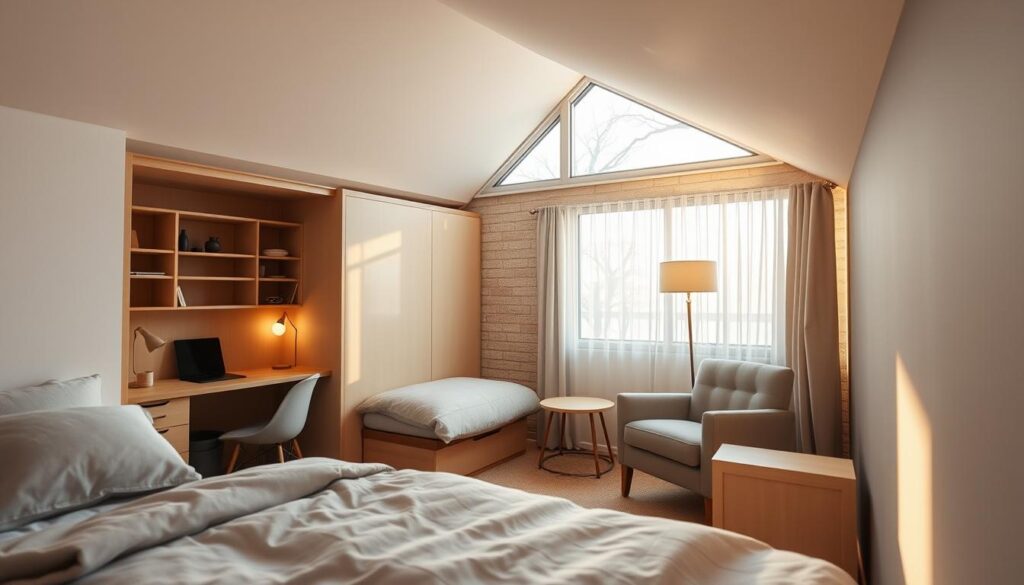
Vertical Storage Solutions
Walls are perfect for storage when the floor is crowded. Shelves that go from floor to ceiling make ceilings look higher.
Over-door organizers are amazing for small spaces. They use space behind doors for things like shoes and accessories.
Under-bed storage boxes are like drawers. They turn unused space into useful storage. Use clear containers so you can see what’s inside.
Multi-Functional Furniture
Every piece in your room should do more than one thing. Think of furniture as a Swiss Army knife — useful but small.
Storage ottomans are great at the foot of your bed. They offer a place to sit, store things, and put on shoes.
A bench with storage can hold blankets and be a reading spot. A desk that folds against the wall saves space when not in use.
Choose furniture that can change with your needs. This way, you don’t need a lot of space for one thing.
Color Schemes for Low Ceilings
Choosing colors for low ceiling bedroom decor is key. The right colors can make your room feel bigger and more open. Colors can trick your eyes into seeing higher ceilings.
Colors set the mood of your room. They show who you are and how big your room feels. The right colors can make a small room feel bigger and more welcoming.
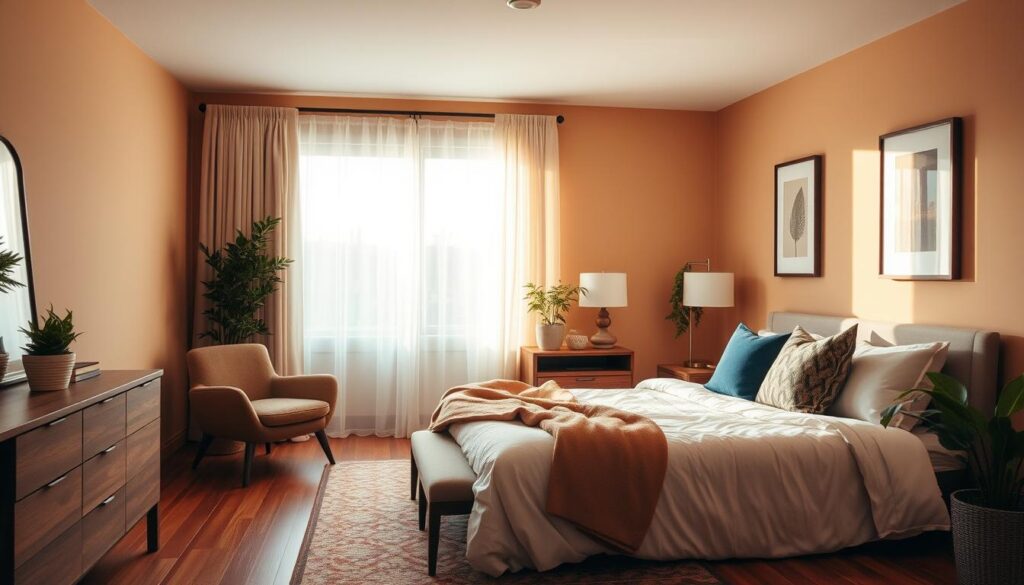
Light and Airy Palettes
Light colors are great for low ceilings. But, light doesn’t mean lifeless. Soft whites, grays, and pastels make rooms feel bigger by bouncing light around.
Benjamin Moore’s Grey Owl is a favorite among designers. It’s a light gray that adds depth but doesn’t feel heavy. Adding white trim makes it even more elegant.
Here are some great color combos:
- Warm white walls with cream accents
- Soft sage green with white furniture
- Light gray with silver metallic touches
- Pale lavender with white linens
Bold Accents for Depth
Using stylish low ceiling bedroom solutions can be surprising. A dark accent wall can make a room feel bigger. It adds depth and focus.
Choose a dark accent wall wisely. The wall behind your headboard is often best. Dark colors like navy or gray add drama without making the room feel small.
Balance is key. Keep most walls light and use one wall for a bold statement. This keeps the room feeling open and interesting.
The Importance of Neutrals
Neutrals are essential for any color scheme. They support other colors without overpowering them. Creams, taupes, and whites let your personality show through.
Neutrals are flexible. You can change your room’s feel with new pillows or artwork without painting. This is great for renters or anyone who likes to update their space often.
Remember, neutrals don’t have to be dull. Mix different textures and shades within the same color family. This adds depth and interest without feeling overwhelming.
Creative Lighting Solutions
Start with knowing each light fixture has a purpose. Think of your lighting like a dance. Each part works together without taking over.
Layer different lights for the best effect. You need ambient lighting for overall light, task lighting for activities, and accent lighting for interest. This makes your room special.
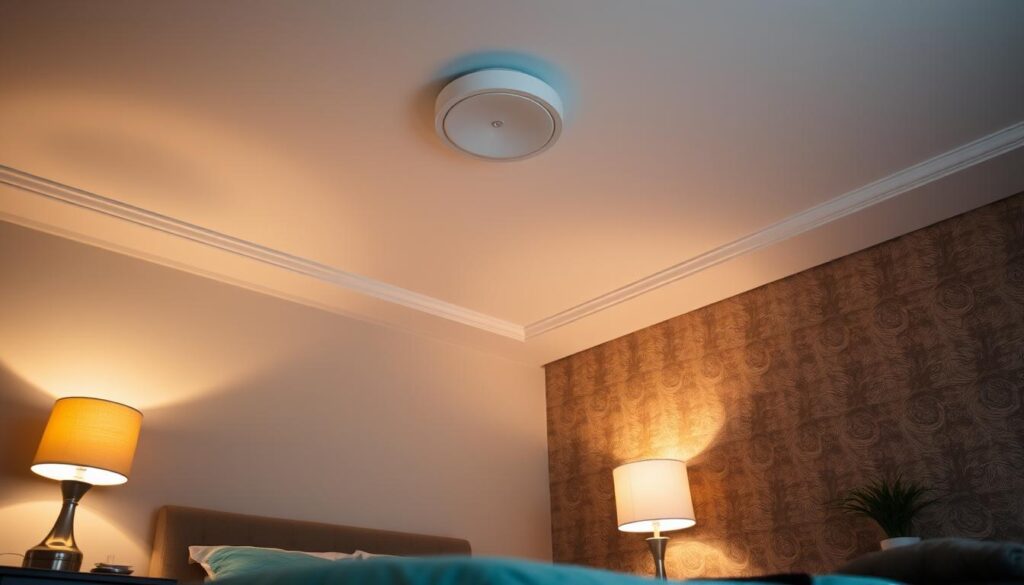
Recessed Lighting Ideas
Recessed lights are great for low ceilings. They sit flat, giving maximum light without taking up space. They’re like helpers that light up your room quietly.
Place recessed lights 4 to 6 feet apart for even light. Use warm white bulbs (2700K to 3000K) for a cozy feel. Dimmer switches are key for changing the mood.
Put recessed lights above your bed or along the room’s edge. This makes your ceiling seem higher.
Wall-mounted Fixtures
Wall sconces let you get creative. They save space and light exactly where you need it. Mount them on sloped ceilings if needed — yes, you can!
Swing-arm sconces are great for reading beside your bed. They adjust and fold away. Uplighting sconces light up the ceiling for general lighting.
Choose fixtures that light up and down. This adds depth to your room.
Floor Lamps for Height
Floor lamps might seem odd in low ceilings, but the right ones make your room feel taller. Pick lamps that light up the ceiling for a height boost.
Torchiere lamps are perfect for this. They light up the ceiling, making your room feel taller. This makes your room feel taller.
Avoid big, heavy lamp bases. Go for sleek designs. Arc floor lamps also work well, lighting up without taking up space.
Embracing Minimalism
When your bedroom ceiling feels too close, minimalism helps. It’s not about living simply. It’s about making every item count.
Pinterest shows how minimalism can make small bedrooms calm. The trick is to know that less is more in tight spaces.
Decluttering Your Space
Decluttering is about making smart choices, not perfection. Ask yourself three things about each item: Does it work? Does it make you happy? Does it deserve space in your small bedroom?
That book pile on your nightstand might need a new home. Decorative pillows that don’t get used can take up too much space. Clearing surfaces makes your room feel taller.
Here’s what to focus on:
- Take things off the floor to clear your view
- Keep nightstands simple with only what you need
- Get rid of things that do the same job
- Store out-of-season clothes elsewhere to free up closet space
Choosing Essential Decor
Choosing decor means picking quality over quantity. One great piece of art is better than many okay ones. Go for pieces that stand out.
The rule of thumb: If it doesn’t make you happy or serve a purpose, it’s probably not needed. Your space should feel welcoming, not empty.
Here are some decor tips:
- Limit each wall to one standout piece
- Pick items with simple designs
- Choose items that do more than one thing
- Use a consistent color scheme
The Art of Simple Design
The art of simple design is about knowing when to stop. Clean lines and empty spaces make a room feel bigger. This is key in small bedrooms.
Where you place things is more important than what you have. A mirror can make a room feel bigger. A single lamp can replace many lights.
Remember: Minimalism is not about giving up. It’s about making room for what’s important. This means better sleep, easier mornings, and a peaceful bedroom.
Using Mirrors to Enhance Light
Mirrors are great for low-ceiling bedroom designs. They reflect light and make your room look bigger. It’s important to pick the right mirror and where to put it.
Mirrors do more than just reflect light. They spread out every bit of sunlight in your room.
Types of Mirrors to Consider
Horizontal mirrors are perfect for low ceilings. They make your room wider, not taller. A long mirror above your dresser or headboard makes your room feel bigger.
Leaning mirrors are easy to move and add style. They’re great for rental homes where you can’t hang heavy things.
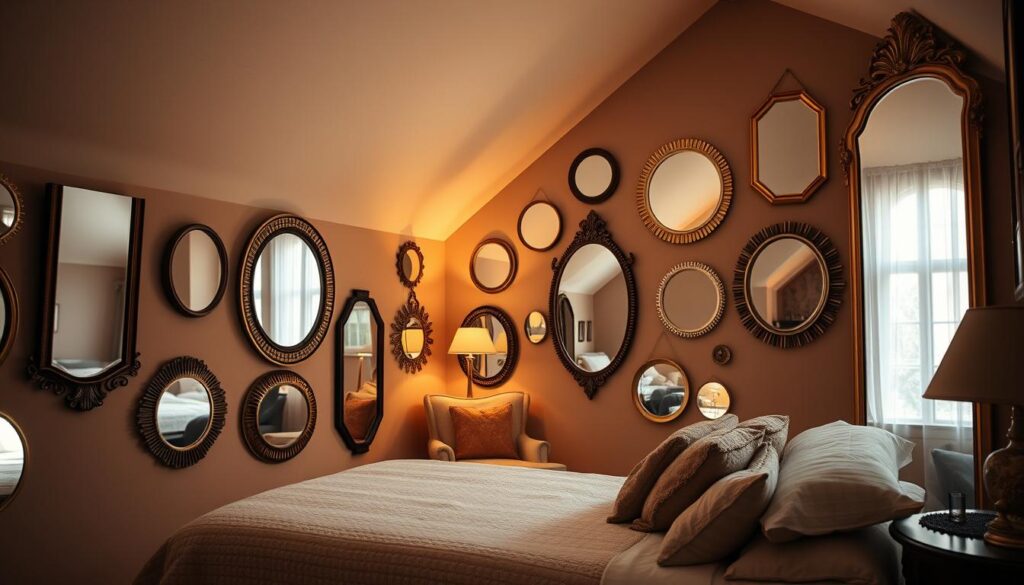
Round mirrors soften corners and add interest. They’re perfect as unique pieces instead of regular mirrors.
Strategic Placement Tips
Put mirrors to enhance light by reflecting windows. Place them on walls opposite windows to spread sunlight. This makes your room bright and airy.
Don’t put mirrors opposite your bed. It’s too much in the morning. Instead, place them to reflect nice things, like art or your nightstand.
Think about the mirror’s angle. It should reflect something nice, not just another wall. This makes your mirrors useful and pretty in your low-ceiling bedroom designs.
Low-Ceiling Bedroom Layouts
The secret to small bedroom design with low ceiling success is in smart layout choices. Your furniture’s placement greatly affects your room’s feel. With low ceilings, each piece must be both useful and visually appealing.
Traditional layouts often center furniture. But low ceilings call for a different strategy. Think about how furniture moves, natural light, and how it fits with your ceiling.
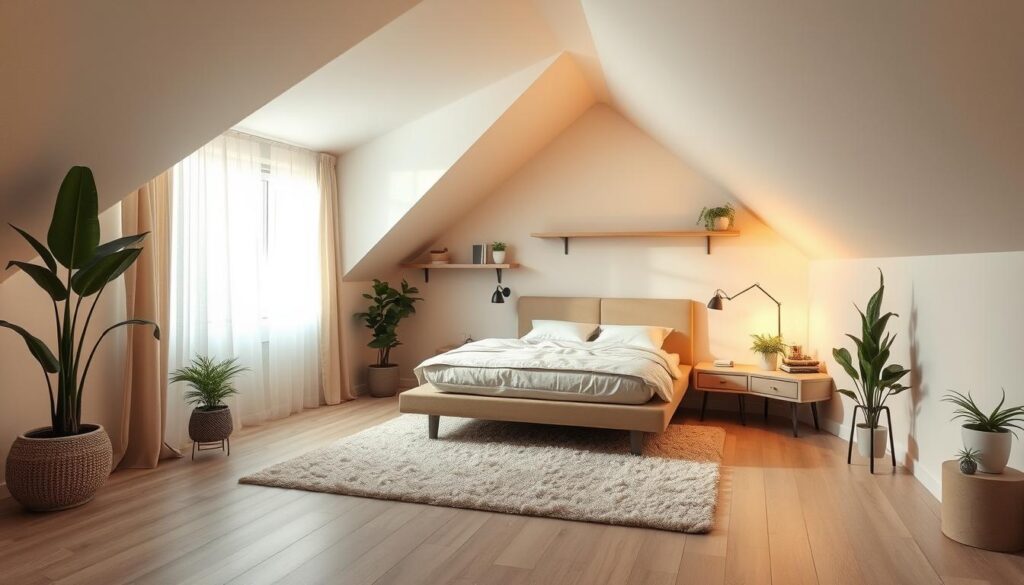
Optimal Furniture Arrangements
Find your room’s sweet spots where the ceiling feels better. Place tall furniture here, like dressers or bookshelves.
Float your bed away from walls to create space. If it’s tight, put big furniture against the lowest ceiling.
Make different zones in your room. Use a small chair and table for a reading area. A bench at your bed’s foot adds seating and storage. These bedroom decor ideas make every inch count.
Bed Placement Strategies
Bed placement is key with low ceilings. Putting your bed against the lowest point makes it cozy. It feels right, not cramped.
Windows are smart too. Place your bed under a window for light and views. A low headboard defines the space without blocking the ceiling.
Corner beds work great for angled ceilings. Tuck your bed into the corner where walls meet. It’s cozy and keeps the floor open.
Avoid centering your bed under the lowest point. Instead, angle or side it. These layouts are often the most comfy and nice to look at.
Textiles and Fabrics to Elevate Design
The right fabrics can turn a low-ceiling space into a luxury retreat. Textiles add personality, warmth, and make you feel like you don’t want to leave. They turn architectural challenges into cozy advantages.
Smart textile choices are better than paint or furniture for low ceiling bedroom decor. They soften harsh lines, add weight, and create layers. This makes spaces feel rich, not cramped.
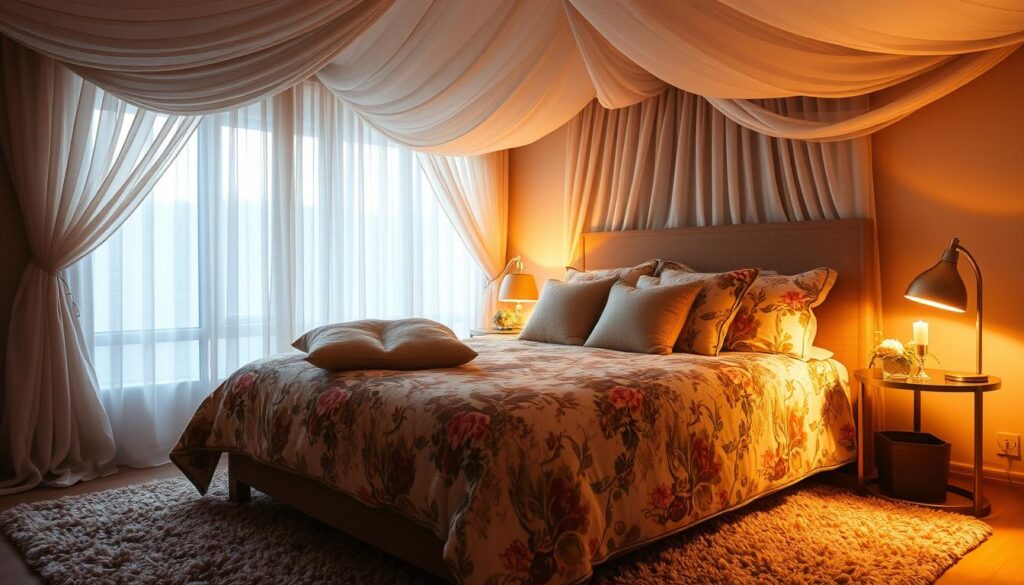
Choosing the Right Curtains
Floor-to-ceiling curtains are great for low ceilings. Mount them as close to the ceiling as you can. This trick makes your room feel taller.
Choose lightweight fabrics in light colors for a ceiling-lifting effect. Linen, cotton, or sheer materials are good choices. Avoid heavy, dark curtains that can make your space feel closed in.
Horizontal patterns can make narrow rooms feel wider. But use them sparingly. Subtle stripes or geometric prints are better than bold patterns.
Layered Bedding for Cozy Vibes
Your bed becomes the room’s focal point with layered textiles. Start with quality sheets, then add a lightweight blanket. Add a throw at the foot of the bed and multiple pillows in varying sizes.
Mix textures for visual interest without overwhelming your space. Combine smooth cotton with chunky knits, or pair linen with velvet accents. This mirrors the sophisticated bedroom ideas in design magazines.
Patchwork quilts add personality and warmth while keeping colors cohesive. Choose quilts with lighter backgrounds and subtle patterns to maintain that airy feeling.
Area Rugs for Warmth
Area rugs define your space and add warmth underfoot. This is important in attic or basement bedrooms with cold floors. Choose rugs large enough to anchor your furniture arrangement.
Light-colored rugs with subtle patterns work best for low ceiling bedroom decor. They reflect light upward and keep your floor from feeling heavy or dark.
Layer smaller rugs for added texture and interest. A small accent rug beside your bed over a larger neutral base creates depth without visual clutter.
Incorporating Artwork Creatively
Your walls tell a story, and in a low-ceiling bedroom, that story needs careful planning. Forget old art placement rules. They don’t work in small spaces. The secret to stylish low ceiling bedroom solutions is knowing how you see art in your room.
You spend most of your time in bed. This changes how you see things. Traditional art heights look odd from down here.
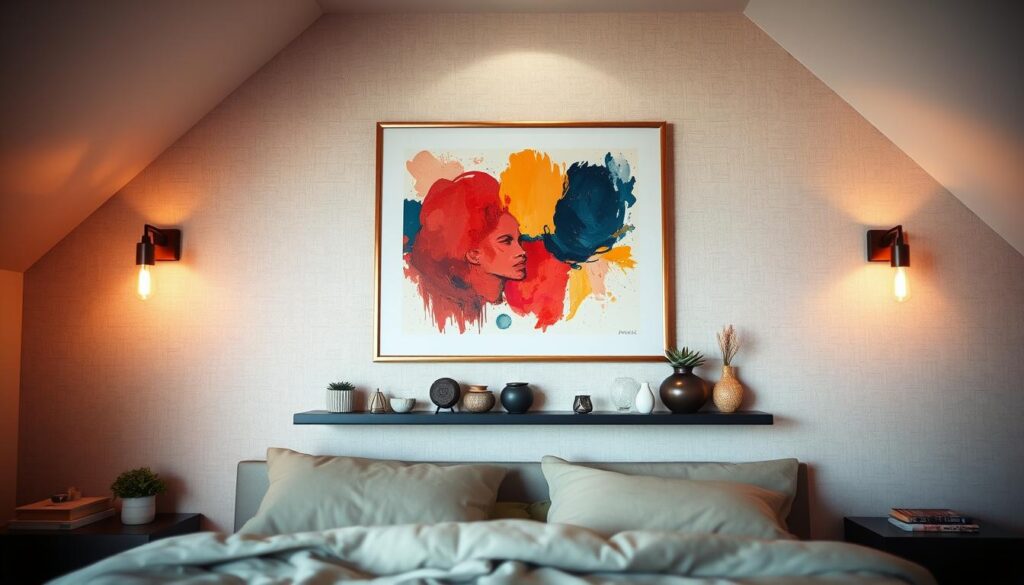
Gallery Walls at Lower Heights
Gallery walls are great in small rooms if you adjust the height. Place your art so the middle is about 50-54 inches from the floor. This makes looking at art feel just right when you’re in bed.
Choose horizontal layouts over tall towers. A wide wall display makes your room seem bigger. Use different frame sizes and shapes, but keep it low and long.
Here are some tips for gallery walls:
- Start with your biggest piece as an anchor
- Build outward with smaller complementary works
- Leave consistent spacing between frames (2-3 inches works well)
- Include personal photos mixed with art prints
- Use matching frames for cohesion or mix metals for personality
Lower gallery walls are easy to change. You can swap pieces, add new ones, or rearrange when you feel like it. This makes them perfect stylish low ceiling bedroom solutions that grow with you.
Using Shelves for Display
Floating shelves become mini galleries that are very flexible. Unlike fixed art, shelves let you create changing displays. Place shelves at eye level when sitting on your bed — about 40-45 inches high.
Make displays interesting by layering items. Put a small framed print behind books, add a tiny plant, and finish with something that makes you happy. This makes your room feel more lived-in than perfect.
Smart shelf styling includes:
- Books as both storage and display elements
- Small plants that don’t require ceiling height
- Personal collections like vintage cameras or ceramic pieces
- Rotating seasonal items to keep displays fresh
Make each shelf tell its own story. Group items by color, theme, or personal meaning. This creates interest that goes across the wall, not up and down.
Theme Ideas for Low-Ceiling Bedrooms
The best creative solutions for low ceilings in bedrooms start with a theme. Choose one that fits your space’s charm. This way, your small space becomes a stylish statement.
Think of your theme as your bedroom’s personality. It guides your color choices and furniture picks. A cohesive theme turns your low-ceiling bedroom into a cozy retreat.
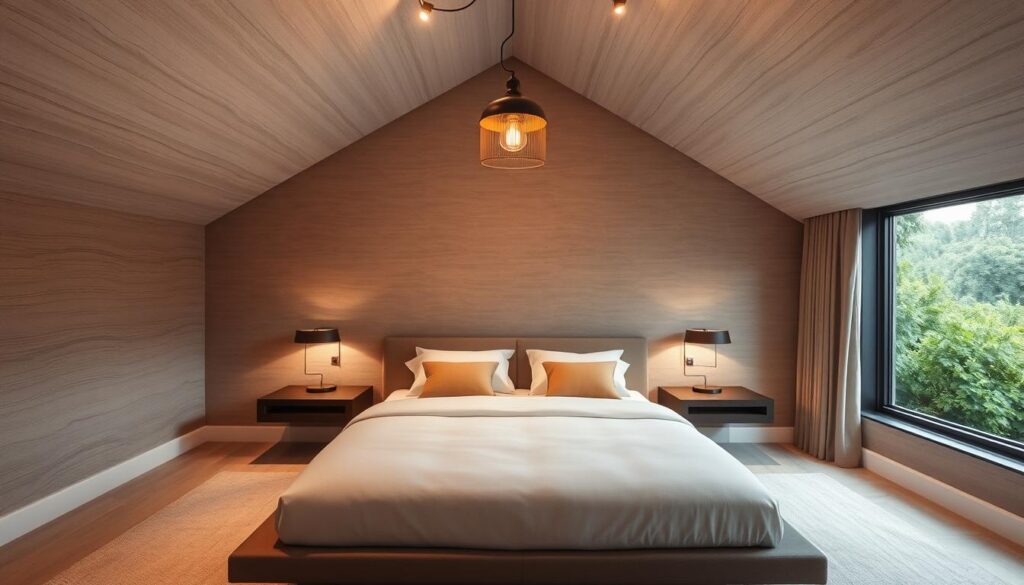
Scandinavian Simplicity
Scandinavian design is perfect for low-ceiling bedrooms. It focuses on hygge, making cozy spaces even cozier.
Start with light woods and white walls. Use pine, birch, and oak furniture to keep it airy but warm. Add soft textiles like chunky throws, linen bedding, and sheepskin rugs.
Follow the “less is more” rule. Pick a few quality pieces over many small ones. A simple wooden bed frame, floating nightstands, and a statement plant create calm simplicity.
- Light wood furniture in natural finishes
- Neutral color palette with whites and soft grays
- Cozy textiles in natural materials
- Minimal, functional decor pieces
Industrial Edge
Low-ceiling bedrooms often have exposed beams and brick walls. Use these as design highlights.
Choose raw materials like metal bed frames and distressed wood furniture. Add warm bedding, area rugs, and soft lighting to balance it out.
Industrial design loves contrast. Mix sleek metal with weathered wood, or smooth concrete with plush textiles. This adds interest without feeling cramped.
- Metal and reclaimed wood furniture
- Exposed structural elements as decor
- Warm lighting to soften hard surfaces
- Mix of textures and materials
Bohemian Relaxation
Turn your low-ceiling bedroom into a bohemian dream with layered textures and warm colors. This style makes small spaces feel cozy and loved.
Use different textiles like tapestries, throw pillows, and vintage rugs. Choose warm earth tones like terracotta and golden yellows to make it cozy.
Bohemian style loves imperfection and personal touches. Mix patterns, display meaningful objects, and create cozy reading nooks. These ideas make small ceilings feel like advantages.
- Layered textiles in rich patterns and colors
- Warm, earthy color schemes
- Personal collections and meaningful objects
- Comfortable, casual furniture arrangements
Plant Life in a Low-Ceiling Space
Plants make any bedroom a living sanctuary. But in low-ceiling spaces, they need to spread out, not up. You can have fresh air and beauty without tall plants.
Think of your low-ceiling bedroom as a canvas. It needs texture and life, not height. The right plants can soften angles, purify air, and look great without feeling cramped. Smart plant placement is key for visual interest and balance.
Best Indoor Plants for Low Ceilings
Wide-spreading plants are great for low ceilings. Snake plants grow in clusters that add texture without being too tall.
Pothos plants are perfect for maximizing space in a low ceiling bedroom. They cascade from shelves, creating green curtains that draw the eye horizontally. They’re also very hardy.
Peace lilies have broad leaves that cover the ground without being too tall. They also bloom with elegant white flowers, adding sophistication.
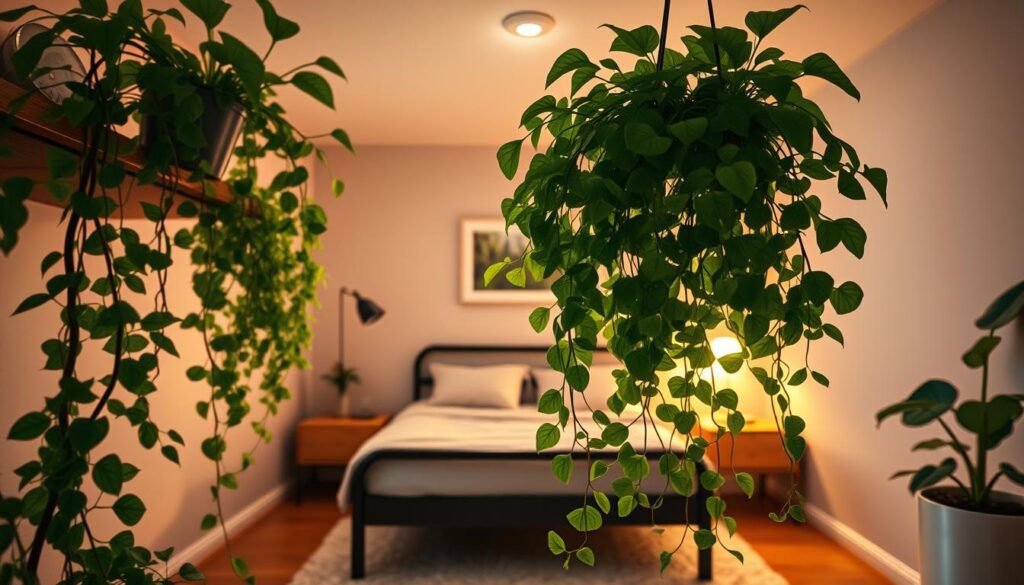
Rubber plants have thick leaves that make great statement pieces. They spread wide, not tall, adding green presence without overwhelming the room.
Hanging Plants for Vertical Interest
Hanging plants are great for low ceilings. They use the upper room without taking up floor space.
Exposed beams are perfect for hanging planters. Macrame hangers add charm, while metal hooks keep things modern.
Spider plants are hanging stars that produce baby plants. They grow well in different lights and are easy to care for.
Window areas are great for hanging plants. Hang planters at different heights to add layers without blocking light. This makes the room feel larger and more connected to nature.
String of hearts or string of pearls add softness and movement. They look great in small pots around the room, creating a flow of green.
Personal Touches and Customization
Adding personal touches makes any low ceiling bedroom special. It’s about loving your space, not just living in it. By adding things that show who you are, the room’s unique features shine.
Low ceiling bedrooms have a special charm. Their unique angles are perfect for making your space stand out. This lets you create a room that’s truly yours.
DIY Decor Ideas
DIY projects are great for low ceiling bedrooms. You can make things fit just right. This is perfect for spots that regular furniture can’t reach.
String lights add magic to low ceilings. They make the room feel cozy and special. Hang them up or through a headboard for a warm feel.
Here are some easy DIY ideas:
- Built-in shelves that match your ceiling
- Custom window treatments that make the ceiling look higher
- Floating nightstands that save floor space
- Wall-mounted lights that you can adjust
- Under-bed storage that fits your space
Personalizing Your Space
Make your room special by celebrating its unique features. Sloped walls are great for cozy reading spots and display areas. Regular rooms just can’t compete.
Turn challenges into design chances. A low ceiling above your bed makes it feel like a cozy canopy. Angled walls are perfect for floating shelves at different heights.
Here’s how to make your space truly yours:
- Photo galleries that follow your ceiling’s shape
- Custom corner shelves for your collections
- Textiles that show off your style
- Plants that fit your light
- Artwork that’s just the right size for your walls
The goal is to show off your room’s unique features. By embracing them, you make your space truly yours.
Accessorizing with Functionality
Your low ceiling bedroom looks best when every item does more than just look good. Smart accessories are the secret heroes of small spaces. They solve problems and add style.
Practical Accessories
That old trunk at your bed’s foot is more than storage. It’s a place to sit, a spot for your coffee, and a bookshelf. Ottoman cubes with hidden storage keep blankets out of sight but ready to use. Wall-mounted shelves save floor space and look good.
Stylish Organizational Tools
Beautifully organized spaces feel planned, not messy. Woven baskets hold magazines and cables, adding texture. Under-bed storage boxes on wheels make changing seasons easy. Wall-mounted jewelry organizers save counter space and look nice.
Your low ceiling bedroom is a success when it looks good and works well. Pick accessories that are both beautiful and useful. Each item should fit perfectly in your space, not hide. When accessories work this hard, your room looks stylish and organized.
